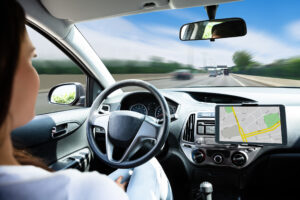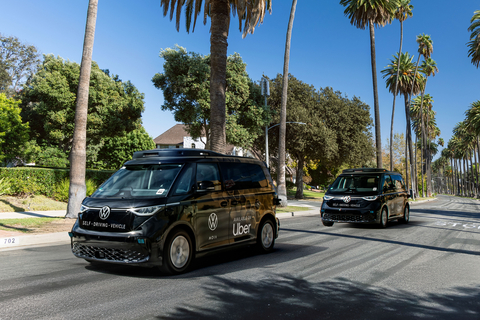
NHTSA unveils new autonomous vehicle regulations to ‘prevent patchwork of state laws’
By onAnnouncements | Technology
The National Highway Traffic Safety Administration (NHTSA) will implement a new autonomous vehicle (AV) regulation framework that it says will maintain key safety standards and prevent a patchwork of state laws and regulations, according to an announcement from the U.S. Department of Transportation (USDOT).
“This administration understands that we’re in a race with China to out-innovate, and the stakes couldn’t be higher,” said U.S. Secretary of Transportation Sean P. Duffy, in the announcement. “As part of DOT’s innovation agenda, our new framework will slash red tape and move us closer to a single national standard that spurs innovation and prioritizes safety.”
NHTSA says the framework consists of three principles:
-
- Prioritize the safety of ongoing AV operations on public roads;
- Unleash innovation by removing unnecessary regulatory barriers; and
- Enable commercial deployment of AVs to enhance safety and mobility for the American public.
First, the Federal Motor Vehicle Safety Standards (FMVSS) will be modernized to ensure safe commercial AV deployment while improving safety and mobility, according to the announcement.
NHTSA maintains its Standing General Order on Crash Reporting for vehicles equipped with certain ADAS and automated driving systems (ADS).
“By streamlining the SGO for Crash Reporting and expanding an existing exemption program to domestic vehicles, we are enabling AV manufacturers to develop faster and spend less time on unnecessary process, while still advancing safety,” said NHTSA Chief Counsel Peter Simshauser, in the announcement. “These are the first steps toward making America a more welcoming environment for the next generation of automotive technology.”
NHTSA said it aims to streamline reporting “to sharpen the focus on critical safety information while removing unnecessary and duplicative requirements.”
“To unleash innovation now, NHTSA is expanding the Automated Vehicle Exemption Program (AVEP) to include domestically produced vehicles,” the announcement states. “Previously open only to imported AVs, AVEP has promoted vehicle innovation and safety through simpler, faster exemption procedures that allow companies to operate non-compliant imported vehicles on U.S. roads.”
The program wasn’t previously available for American-built vehicles. NHTSA says the new framework levels the playing field by expanding AVEP to domestic vehicles while eliminating “a needless roadblock to innovation.”
NHTSA announced the change in an April 24 letter to AV developers.
John Bozzella, Alliance for Automotive Innovation (Auto Innovators) president and CEO, called the changes “unequivocally good and overdue.”
“That this is among the first policy announcements from Secretary Duffy and the new team at NHTSA is a signal that AV policy in America isn’t an afterthought anymore,” he said in a written statement. “This technology works. It will help improve safety on the roads and increase mobility. But the ability of AV developers, investors, automakers, and consumers to reach their full potential has been hamstrung by government inaction. It’s time to move to the next phase of autonomous driving in America, and that requires – urgently requires – a regulatory framework and a pathway to finally and fully deploy AVs in the country.
“Yes, we’ve got to move smartly and safely. But this announcement shows the administration is also proceeding with a sense of urgency, so we don’t cede AV leadership to China and other countries. Time is of the essence. Let’s get an AV framework in place and make sure the autonomous future is built and developed here at home.”
In its “AV Roadmap,” Auto Innovators recommends that USDOT establish a national pilot program for AV testing and deployment to advance DOT AV research objectives and provide AV developers with an alternative pathway to AV testing and deployment.
“A focused pilot program carried out under DOT’s oversight could increase public exposure to the technology and provide the DOT with the data that it will need to create new safety regulations for AVs,” the roadmap document states.
The document also states that the federal motor vehicle safety regulatory standards and exemption petition process should permit manufacturers to submit vehicle-specific technical design and/or build documentation to “empower manufacturers to use innovative safety assurance techniques, such as virtual testing with validated simulators.”
According to the roadmap, Auto Innovators says DOT should also allow the use of a surrogate vehicle (i.e., a vehicle that shares the same platform as the AV but has conventional driver controls) to perform certain regulatory compliance tests.
On Thursday, Volkswagen Group’s autonomous mobility subsidiary Volkswagen ADMT, LLC, and Uber announced a partnership that they say will deploy a fleet of thousands of all-electric, fully autonomous ID. Buzz AD vehicles in multiple U.S. markets within the next decade.
Testing is expected to begin later this year, with the first commercial launch slated for 2026 in Los Angeles.
According to a press release from the companies, ID. Buzz AD vehicles will have operators onboard to help refine the technology and ensure safety during the initial testing and launch phase. Each step will proceed only after any necessary regulatory approvals have been received.
MOIA, a Volkswagen AG autonomous mobility brand, will provide its integrated solution for autonomous driving, which includes the ID. Buzz AD and software-based system for deployment on the Uber platform.
“Volkswagen is not just a car manufacturer — we are shaping the future of mobility, and our collaboration with Uber accelerates that vision,” said Christian Senger, CEO of Volkswagen Autonomous Mobility, in the release. “What really sets us apart is our ability to combine the best of both worlds—high-volume manufacturing expertise with cutting-edge technology and a deep understanding of urban mobility needs.”
Uber CEO Dara Khosrowshahi added, “This collaboration marks a significant milestone in the advancement of autonomous mobility, and highlights both Volkswagen’s and Uber’s shared dedication to building the future of transportation,” said . “We can’t wait to launch in Los Angeles late next year.”
In October, while backing support for federal AV safety standards, University of Michigan researchers invited academic researchers to use its mock city remotely for AV and connected vehicle testing.
Within the year, Mcity plans to assist 10 research teams from academic institutions in the U.S. with their testing needs.
The goal is a full simulation version of Mcity that industry and academic researchers can use to “rigorously test and validate” AVs to accelerate their development and adoption.
Images
Featured image credit: AndreyPopov/iStock
Secondary photo provided by VW

